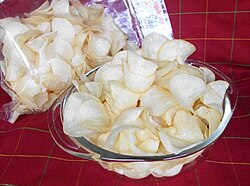A request that this article title be changed to Tapioca chips is under discussion . Please do not move this article until the discussion is closed. |

Tapioca chips are a snack food made from thin wafers of deep-fried cassava root. It is commonly found in South India, and Sri Lanka, as well as in Indonesia where it is known as kripik singkong (cassava chips), and in Malaysia known as 'kerepek ubi'.
Contents
- Overview
- Variations
- India and Sri Lanka
- Indonesia
- Commercial tapioca chips
- See also
- References
- Further reading
- External links
It is also a bulk commodity product that is produced and traded, and in this form is used to create products such as alcohol, animal feed, biofuel, and starch.


